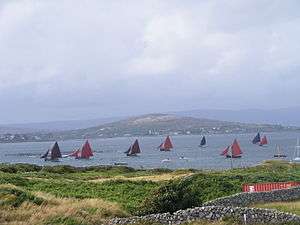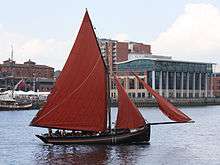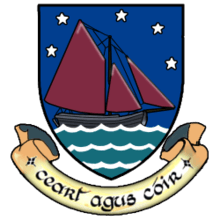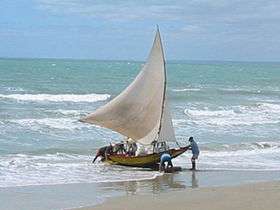Galway hooker
The Galway hooker (Irish: húicéir) is a traditional fishing boat used in Galway Bay off the west coast of Ireland. The hooker was developed for the strong seas there. It is identified by its sharp, clean entry, bluff bow, marked tumblehome and raked transom. Its sail plan consists of a single mast with a main sail and two foresails. Traditionally, the boat is black (being coated in pitch) and the sails are a dark red-brown.

Recently there has been a major revival of and renewed interest in the Galway hooker, and the boats are still being painstakingly constructed. The festival of Cruinniú na mBád is held each year, when boats race across Galway Bay from Connemara to Kinvara on the Galway/Clare county boundary.
Classes of Galway hooker

The hooker refers to four classes of boats. All are named in Irish. The Bád Mór (big boat) ranges in length from 10.5 to 13.5 metres (35 to 44 feet). The smaller Leathbhád (half-boat) is about 10 metres (28 feet) in length. Both the Bád Mór and Leathbhád are decked forward of the mast. These boats were used to carry turf to be used as fuel across Galway Bay from Connemara and County Mayo to the Aran Islands and the Burren. The boats often brought limestone on the return journeys, to neutralise the acid soils of Connemara and Mayo. The Gleoiteog ranges in length from 7 to 9 metres (24 to 28 feet), and has the same sails and rigging as the larger boats. They were used for fishing and carrying cargo. Another boat, the Púcán, is similar in size to the Gleoiteog but has a lug mainsail and a foresail. These smaller boats were entirely open.[1]
There was also a class fitted with a cockpit floor over the ballast used for fishing. When the Irish settlers at Boston in North America needed fishing craft, they built the hooker that they knew from home. These boats became known as 'Boston Hookers', 'Irish Cutters' (in official reports), or 'Paddy Boats'.[2]
While a very utilitarian boat, well suited for the shallow waters of Galway Bay and being capable of being beached where necessary, the Galway Hooker is prone to being swamped and sinking in a short time in the absence of a cabin and high freeboard.
Eighty-two shipwrecks are recorded in the unpublished 'Shipwreck Inventory of Wrecks for Galway Bay'. These wrecks date to between 1750 and 1938; of them, 59 are from the 19th century. No records are currently known to exist for the period prior to the 18th century. Cargo throughout this period would usually be held in wooden casks varnished with fish oil for waterproofing.
Origins
The origins of the craft are not clear. A major spark in the revival of interest was the publication in 1983 of The Galway Hookers: Sailing work boats of Galway Bay (Richard J. Scott, d 24/01/08)—now in its fourth edition—in which for the first time detailed construction and sail plans were published.
References in popular culture
- Scottish actor Sean Connery, playing the role of Irishman Michael McBride in Disney's 1959 film Darby O'Gill and the Little People, sings a song about "a pretty Irish Girl" that includes the line "crimson sails of Galway Bay, the fishermen unfurl".[3]

See also
Notes
- Scott
- Chapelle
- amandablaze007 (2010-01-07), Sean Connery Singing in Darby O'Gill and the Little People, retrieved 2017-03-09
- Reddit (2018-04-20), Is Solus logo a sail boat?, retrieved 2018-04-25
References
- Scott, Richard J (1983) The Galway Hooker. Ward River Press. ISBN 0-907085-58-X
- Chapelle, Howard I (1951) American Small Sailing Craft. W W Norton & Co. ISBN 0-393-03143-8
External links
| Wikimedia Commons has media related to Galway Hookers. |

